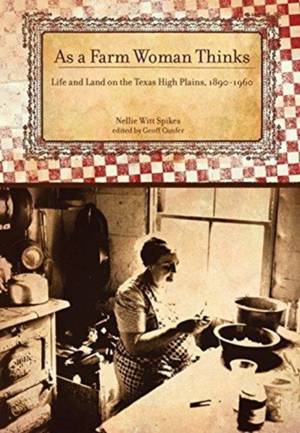
- Afhalen na 1 uur in een winkel met voorraad
- Gratis thuislevering in België vanaf € 30
- Ruim aanbod met 7 miljoen producten
- Afhalen na 1 uur in een winkel met voorraad
- Gratis thuislevering in België vanaf € 30
- Ruim aanbod met 7 miljoen producten
Zoeken
€ 45,45
+ 90 punten
Uitvoering
Omschrijving
In twenty-five years of syndicated columns in small-town Texas newspapers between 1930 and 1960, Nellie Witt Spikes described her life on the High Plains, harking back to earlier times and reminiscing about pioneer settlement, farm and small-town culture, women's work, and the natural history of the flatlands and canyons. Spikes's life spanned the arrival of Euro-American settlers, the transition from ranching to farming, the drought and dust storms of the 1930s, and the irrigation revolution of the 1940s. Engaging and eloquent, her "As a Farm Woman Thinks" columns today conjure up a vivid portrait of a bygone era. Spikes's best pieces, organized topically and then chronologically here by Geoff Cunfer, are illuminated by black-and-white historical photographs featuring people, landscapes, small towns, farms, and ranches that populated the caprock-and-canyon country of her West Texas. Cunfer's introduction and editorial commentary provide context. For historians, As a Farm Woman Thinks enlarges our understanding of a wide land and its culture. For the rest of us, Spikes's "poetry of place" still captures the spirit of the Plains and, decades later, inspires imagination and memory.
Specificaties
Betrokkenen
- Auteur(s):
- Uitgeverij:
Inhoud
- Aantal bladzijden:
- 288
- Taal:
- Engels
- Reeks:
Eigenschappen
- Productcode (EAN):
- 9781682830116
- Verschijningsdatum:
- 1/11/2019
- Uitvoering:
- Paperback
- Formaat:
- Trade paperback (VS)
- Afmetingen:
- 152 mm x 229 mm

Alleen bij Standaard Boekhandel
+ 90 punten op je klantenkaart van Standaard Boekhandel
Beoordelingen
We publiceren alleen reviews die voldoen aan de voorwaarden voor reviews. Bekijk onze voorwaarden voor reviews.











